If you are experiencing a problem with your farrier, vet, or even a client, and you have not been able to resolve the problem, the following series of steps may assist you in conflict resolution. It is not the goal of farriervet.com to persecute anyone. The goal is to assist you to resolve a problem with everyone’s best interest in mind.
For example, I hear many complaints about other farriers because I have been approached to assess the horse for lameness or give a second opinion. I am only hearing one side of the story. I try to keep an open mind. What has been concerning me is the number of complaining clients who describe their horse being severely lame following farriery, aggressive or abusive behavior directed at either the client or the horse, and that they have tried to resolve the problem following the steps outlined below and have not had a satisfactory resolution to their problem.
Advice for women. Be direct, say what the problem is, offer a solution, state what you need the other person to do for you. Leave out the indirect expressions such as I think, I feel, maybe, possibly, could you, what ever you think etc. If you want the farrier to return your phone call in less than 2 days, say so!
Advice for men. It is more than fixing the problem, women appreciate you listening to what they have to say about how the problem has affected them. Women love their horses and will feel great empathy for them.
- Have you told the person who has provided the farriery or other service to you that there is a problem? You should do this before you tell anyone else. You may be damaging someone’s reputation.
- After outlining the problem to the person concerned, have you offered a suggestion for how to resolve the problem? For example ‘my horse was shod 3 days ago and now it is lame, would you please come and check the shoeing to make sure that is not the problem?’
- Often the communication between client and farrier is poor. Not returning phone calls is the most common complaint. Lack of action once a problem has been identified is another.
- If you have outlined the problem and suggested how to resolve the issue, or offered a compromise, and you have not received a satisfactory response, then you should if possible try again to resolve the problem through clear communication, and only then should you resort to making a formal complaint.
- SEND YOUR COMPLAINT IN WRITING. In an unemotional style, (leave out I feel and I think), briefly list your details, the date, the date of any particular incident or event, location, and all relevant details of horse or farrier, witnesses etc. relevant to the issue. Then offer your suggestions for resolution of the problem. Emotional input to this will decrease the validity of your arguments and will cause many people to dismiss the complaint out of hand. You must include in this a date by which you would reasonably expect to receive a reply e.g., 14 days, and send this to the person with whom you are lodging a formal complaint. Make sure that you can be contacted during this time, offer address, phone, mobile and email so that no one can say they could not contact you. Retain at least one copy for your own records. If your complaint is ignored you should make an attempt to confirm that the complaint has been received. If you still receive no reply or resolution and you have exhausted all reasonable methods of conflict resolution you can make a complaint to a governing body such as a farriers association, etc. Refer to the list below for more information on farriery associations and addresses.
- Remember that you employed this person to perform farriery procedures on your horse.
Did you check whether or not they were qualified?
Did you assess the work yourself?
Were you present? For example I am very reluctant to work on any horse without the owner or their representative present.
If you have employed an unqualified trimmer and not a professional farrier there may be no organisation that you can go to with your complaint. However, it may be to the benefit of other horse owners and farriers if you at least give a copy of your complaint to the farrier’s association in your state or country so that they can make a record of it, and should they cross paths with the person who has performed poor work they may be able to offer advice or guidance.
What can stretching, Velcresion Therapy ®, Postural Re-Alignment Programme, Osteopathy, Massage, Acupuncture and Yoga do for you? Extend your working life and increase your comfort while you are shoeing horses! How is this achieved? By taking responsibility for your own mobility and being proactive about maintaining normality. Begin looking after yourself. Listen and apply the advice you receive about how to maintain your mobility and flexibility when that advice is given by professionals who treat farriers, people with sports injuries and others with chronic back pain. This advice may come from a masseuse, osteopath, sports injury specialist or yoga instructor, physiotherapist etc. If you begin to hear the same thing again and again about your back, LISTEN – the universe is trying to send you a message. A proactive approach is essential if you intend to have a long career in farriery. The same theme of stretch and strengthen has been told to me again and again and I am guilty of ignoring the advice thinking that helping myself could wait until later. Now it is later and I am paying the price. It is never too late to start and I have begun to take better care of myself, but I wish I had started sooner.
My story: During my late teens and 20’s I suffered from numerous injuries to my back and neck. I dived into shallow water and hurt my head and neck, I was lucky I didn’t break it. I fell off horses in most directions until I eventually realised it is safer not to ride uneducated horses for other people. These injuries included landing on the base of my neck, concussion (several times), a broken pelvis, broken ankle and a probable fractured skull. I also had the usual young horse injuries of kicks to the knees and some serious bumps and bruises. During this time I was lifting heavy feed and water buckets and this injured my shoulder joints and resulted in chronic pain and weakness in my arms. Then in my late 20’s I took up farriery as a trade qualification. The 4 year commitment was daunting. I truly suffered through some of this with chronic fatigue and muscle pain due to a virus and other health issues. With help from Pat Coleby an organic farming consultant and author of Natural Horse Care (publisher Grass Roots Pty Ltd) my health and physical strength improved and work became easier. It is ironic that despite knowing Pat well and listening to many of her lectures and applying the principles to my horses and other pets it took a serious crisis for me to ask her for help. I have been taking supplements and avoiding my known food allergies ever since and I have steadily improved. For those who have had chronic fatigue you will understand what I mean when I say that you never feel cured but you do feel better as long as you work at it. At the end of my apprenticeship I decided to become a vet as well and that involved 6 years of school and university in my late 30’s while shoeing for a living to pay my way. After years of farriery the back pain was thoroughly established but I was in such a tight financial bind that I sacrificed my back to maintain a flexible income while working around my university commitments, until I could earn a living as a vet. I still shoe whenever I am able and the case is deserving. Ideally a little farriery every day is the best way for me to keep fit and maintain the necessary level of skill.
During the last 20 years only 2 or 3 people have manipulated my neck or back with any success and it is these people who have kept me functioning. I am extremely grateful to Stephen Hope Assoc. Dip. Nat., Dip. Nat. Ther. MCMA, FANTA an osteopath and one of the few who can “fix my neck” when it has gone into spasm so severe I cannot lift or turn my head, or use my arms effectively. The muscle spasm and pain takes weeks to resolve even with regular therapy and manipulation. This problem usually begins with a simple movement such as brushing my hair, putting on a seat belt or turning my head and always happens in the morning. I am aware prior to these events that my neck is bad and I have either avoided getting treatment thinking it can wait, or I have been unable to get treatment and then paid the price. Between these episodes sometimes years apart I have relied on other massage and sports therapists to keep me going as I have moved around the country. The best massage therapist I have met is Amanda Squires D.R.M., A.T.M.S. Amanda is based on the central coast of NSW. I was introduced through other horse people who had experienced benefits from her therapy. Amanda uses massage and Velcresion Therapy® which is her own unique therapy to break up adhesions of the muscle and fascia to enable stretches and pulpations to manoevre and mobilize joints, hinges and vertebrae into their correct functioning positions. To put it in her own words “Velcresion Therapy® is confronting” at times. I have had several treatments with Amanda and feel great benefit from it. I now do her series of stretches developed for people with chronic problems of the neck, shoulders and back on a daily basis and particularly when I have been bending or shoeing. For me a combination of therapies and therapists is essential as I cannot always see Stephen or Amanda and I need to maintain the flexibility and fitness required for shoeing which I love with minimal pain wherever I am at the time.
Click on links for contact details.
Please note I receive no financial or other gratuity for recommending the above mentioned persons and services.
“If he has not good feet, there is no profit in him as a war horse” (Xenophon 430-354 BC).
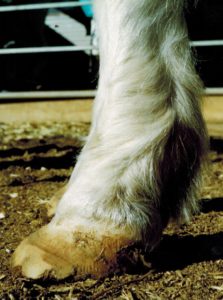 |
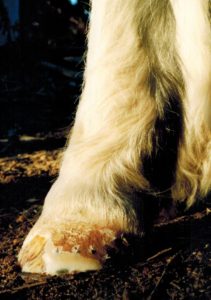 |
|
| A neglected pony foot. The wall has become long and flared due to a damp environment. The wall is cracked and breaking off in large pieces. This can result in abscesses and lameness. | After trimming, the concave sole is restored. The flared and broken wall have been removed. Regular trimming is required to prevent this from recurring. |
The outer, dense layer of wall and sole is called the hoof. In its normal environment, it is sufficient to protect the sensitive inner foot from injury. Under totally natural conditions, the wear rate and growth rate would be equal. When man domesticated the horse, he expected it to carry or pull heavy loads over long distances, which caused the wear rate to exceed the growth rate of the wall and sole. Horses became foot sore, then lame. Man then began to develop the method of shoeing horses that we still use today. Prior to the Iron Age, the main traffic in horses was from Turkistan over the Caucasian Mountains to Asia. By 2000 BC horses were established in the Middle East. The Assyrians are credited with the first blacksmithing skills. By 1400 BC, iron was used by the Hittites, who, through war and trade with neighbors, spread this knowledge to Mesopotamia, Egypt, the Aegean and along Bronze Age trade routes to Italy. It reached Europe only about 700 BC and Britain no earlier than 400 BC. In 500 BC forging any hard metal into a malleable material and then into a horseshoe, spear, or horse’s bit was considered an almost magical procedure, more related to religion or sorcery than blacksmithing. Shod horses made warfare on a large scale possible. A shod horse would have been like an all terrain vehicle. It was ready to go anywhere, over any surface, at any time. The army of Alexander the Great, (356-323 BC) during its march through Asia was impeded when the horses wore down their hooves and became lame and were often abandoned. Many ancient Roman authors made mention of hoof conformation and methods to preserve it. They did not speak of shoeing as such, only ways of protecting the hoof, if necessary. Hipposandals have been found wherever the ancient Romans settled; they were strapped onto the horse’s hoof. While not very practical they are regarded as the forerunner of steel shoes. Farriery is an art, science and a profession, first written of as far back as 400 BC, when the ancient Gauls and Celts nailed a rim of iron to their horse’s hooves. In Japan until the 19th century, horseshoes were made from plaited rice straw, supplies of which were carried or purchased en route. These examples of shoeing horses or protecting the foot from wear can be compared to the use of modern horse boots e.g., “Old Mac’s”, Easy Boots, glue on shoes and other nail-less ways of shoeing and protecting the foot and preventing the wear rate from exceeding the growth rate. The reasons why we shoe horses using any of these methods are exactly the same now as they were 2000 years ago. The first and most important reason is to protect the foot and minimise wear of the wall when a horse is moving over a variety of surfaces that may otherwise cause the horse pain and discomfort due to wearing the feet too short and sole pressure. Stones and rocks can cause significant injury and bruising. Shoeing lifts the foot above the ground and increases the concave space under the sole which minimises injuries and sole pressure. Steel shoes and nails are still the most economical, practical and effective way to protect the foot in most cases as all nail-on or nail-less methods have some complications and no one method suits all horses for all purposes. Shoeing is also used as therapy for a lame horse or as part of treatment of a foot condition.
Why do we shoe horses?
- When the wear rate exceeds the growth rate of the hoof, resulting in short feet and lameness. In a natural environment, the wear rate of the hoof is equal to the growth rate.
- To protect the sole from injury when moving over rough surfaces.
- To maximise soundness in younger and older horses – to reduce the risks of poor conformation leading to early breakdown.
- As an aid to treatment of injury and disease.
Wild horses travel over large areas, up to 20 miles per day in search of food and water. The hoof chips off in small pieces, or wears away, encouraging hoof function and normal shape. Horses with poor hoof or limb conformation are predisposed to foot problems and lameness as a secondary effect of the conformation fault. Trimming and shoeing can minimise conformation faults in younger horses and maximise the potential for soundness in older horses while improving hoof shape and function. When humans over-confine horses, supplying all their food and water requirements, the growth rate of the hoof exceeds the wear rate. Normal hoof function and shape may be compromised and the hoof must be trimmed or shod. Trimming and maintenance of horse’s hooves at regular intervals is absolutely essential if horses are to live in the human environment.
Trimming theories
The four point trim, the wild horse trim and the natural horse trim are names given to trimming methods developed from research studies and theories about what is the best way to trim a horse based on feral horses hooves. From this farriery practices have been developed which are often controversial and in some cases poorly applied. In the main the feet of American feral horses, domesticated horses that are allowed to live free for many generations were studied. It has been shown that some are genetically related to the original American mustang. This is fitting as this is the continent on which the horse evolved. It has long been known that in natural conditions; which I would describe as unlimited space, some hills, some rough ground, seasonal climate with a dry summer and moderate feed for grazing; horses develop feet that are worn at the toe, with wall that is shorter at the quarters, the feet have minimal flare and the hooves are usually in a state of balance neither too long or too short. This is consistent with horses which cover a large area in dry conditions to obtain feed and water in summer. In the most severe cases the toe becomes so worn that the theory of the four point trim was born. In this case only the heels and the wall either side of the toe is fully weight bearing. A comment by a leading researcher at a farriery seminar summed up the facts. These are horses which are under conditions of natural selection and pushed to the limit of their survival because their feet are almost worn to the point of being too short to be comfortable. A lame horse is the wild is a dead horse soon after!! When a horses feet are so short and sore that it cannot forage for food and walk back to water it is doomed if there is a predator big enough to attack and kill it.
A point that is rarely mentioned about these theories is that each horse’s genetic potential is a large part of why that particular horse develops a foot problem. If a horse has the genes for good conformation and for good functional feet it has a much better chance of survival under wild conditions as well as domesticated conditions. The horses studied were not randomly selected from the domestic pool of horses which are currently shod in Australia, England, Europe or even America and then put into these conditions. The horses studied are under true conditions of genetic selection for survival over many generations. Therefore, how do these horses feet compare to the pool of horses which we are faced with as farriers, vets and horse owners in any particular country or breed of horses? For those horses with flat feet, low hoof pastern angles, club feet and toe-in or toe-out conformation, nothing done to the external hoof capsule including wearing it all away and making the horse sore will ever change its genetic potential to pass on bad feet to its offspring. Contrary to what some people think, feet don’t toughen up, they are affected by the forces of nature in the environment in which they are kept, a good environment e.g., large area, dry with some gravel and plenty of feed and water can help to improve feet and a bad environment e.g., small, wet in winter, wetter in summer, muddy paddock with no feed or shade will make them worse. When the severely flat footed horses “go naked” in a bad environment all that happens is that they hobble about in misery developing flared feet, hoof wall cracks, abscesses, sole pressure and bruising. Incorrect over trimming adds to the problems and no matter how long you keep the foot naked it will never develop a deep concave sole, or change the angle of the distal phalanx within it. The naked and natural theories have also been partially developed in relation to horses which are over confined, have a tendency to contracted hoof shapes and upright pasterns e.g., feet such as occur on Warmbloods kept in Europe. This is a combination of genetic potential and environment. In a harsh winter climate it is necessary to have horses stabled. This a far cry from many Australian horses which are Thoroughbred, Standardbred or Thoroughbreds crossed with an Arab, Warmblood, Stock horse or Quarter horse. Some crosses improve the feet, but a few horses inherit the worst features of both the dam and the sire. The majority of these horses would get some free exercise every day.
What am I using to base my statements upon? Seeing horses which have never been shod which have inherited such poor hoof conformation from their dam and sire that by the time they are 12 months old they require front shoes just to be paddock sound. These horses were well bred, well fed, on good surfaces and received professional farriery care so that neglect was never a factor. Viewing up to 4 generations of the same sire line has convinced me that the feet were true to their genetic potential. Kept shod they would race or perform to their best, left unshod they would be footsore and lame. What is the answer? Don’t breed from them! This is why it is more important to buy good conformation below the shoulder than above. Farriery was developed over 2000 years ago because the Greek Army horses wore out their horse’s feet and they became lame. The wear rate exceeded the growth rate. This is still the main reason that we shoe horses today, to protect their feet from becoming too short and then the horse becoming lame. The researchers of these theories have concluded that we should try and return horse’s feet to this natural form under natural conditions in a bid to cure horses of many forms of unsoundness which are due to the unnatural conditions in which we force horses to live. Their recommendations include, unlimited exercise, removing the flare from the feet, creating a bevelled edge on the wall, removing weak, folded and excess heels or bars and creating a bevelled toe that allows ease of break over and trimming the horse every 3 – 4 weeks at the maximum. This is exactly what most farriers would have you do with an unshod horse under perfect conditions. This is not new information, but it is more expensive and that is where most of the resistance from clients comes from. It is often very difficult to convince people (even when they ask for your recommendations) that more frequent shoeing or trimming are the answer to their horse’s problem (little and often) because everything comes back to what people can afford. However, when a regular routine is established and the horse is well fed and able to exercise freely it will have feet which are never out of balance and always look and feel great! One problem facing professional farriers and the horse-owning public is a wide base of unqualified and unprofessional people who charge money for trimming and shoeing but do not deliver a good standard of service. This low standard of work at lower prices is what many people compare to as normal when discussing the benefits of the barefoot and natural over conventional farriery. My feeling is that many people in Australia have not yet had the benefit of a high level of professional service and that the bad experiences they have had have steered them towards the naked hoof message. A good farrier produces a trim which fulfills all the requirements of natural and balanced and would never suggest shoeing a horse that will be able to do whatever the rider requires and remain sound and happy unshod. Shoes are for those horses that need them. My message is, there is nothing new in farriery. When you apply a fancy name to something and promise to change a horse’s feet over 12 months with this new method people are impressed, it is often the first time the principles have been discussed by the horse-owner in this way. There is no harm in marketing your product. I only become concerned when the principles which are all part of normal good farriery practice are abused. Horses have had their feet so severely trimmed in the name of naked, barefoot and natural that the horse becomes very sore and the client is told that this is all part of the process and the horse needs to go through this phase to get better in the longer term. This pain represents previous damage to the foot. What this pain really represents is what is happening right now!! No one has the right to trim a horse’s feet so short that it is sore. This is injuring the horse, it is cruel and will not speed the process. The golden rule of veterinary medicine, farriery and trimming your own horse’s feet is “first do no harm”, if your horse has bad feet, trim it “little and often”. I am confident that poor hooves can be dramatically improved by one years worth of good, regular farriery care; but, if that good farriery stops the hooves will revert to what ever problems they had previously if the hoof is predisposed to it by poor limb and foot conformation or environmental factors such as wet ground and poor diet. Naked and natural work best when a hoof is normal conformation or is slightly contracted. When a hoof is abnormal e.g., flat soled that must be dealt with first. A horse limping around with thin, prolapsed soles due to poor conformation, flat feet or neglected chronic laminitis and sole pressure is miserable and requires “professional” quality farriery to relieve the discomfort. In the short term shoes e.g., glue-on, nail-on, slip-on etc., or reconstruction techniques may be essential to give that animal comfort. Providing non painful answers to our farriery problems is our obligation as horse-owners, farriers and veterinarians. So the answer to this issue is yes, there is a lot of good in the core of trimming theories and natural horse ideals. But, beware of those who have got hold of some of the information and some of the principles and then try to baffle you with “bull-dust” and leave you with a horse that has been over-trimmed and is foot sore. Farriery is all about leaving the horse sounder than you found it.
If common sense was common, it would not be a highly prized commodity.
DO THE COMPARISON TEST
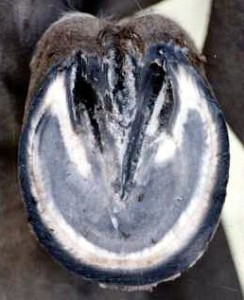
Does your horse have healthy feet? Using this photo as an example, compare yours horses feet next time the farrier is there. This foot is two equal halves either side of a centre line (balanced). The sole is concave, (the sole can descend under load without causing sole pressure and pain). The white line is white, not stretched, red (bruised), black (necrotic) or laminitic. The foot is in the process of being prepared for a shoe which, when fitted, will cover the heels and extend back to the widest part of the frog. Are your horses shoes long enough?? There is no bruising in the space between the heels and bars or along the laminae of the bars which have been trimmed level to the sole. Overall this is a very healthy foot.
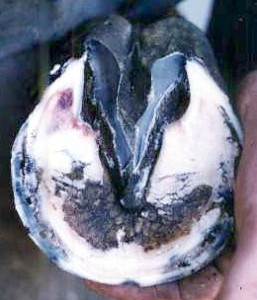
Compared with this foot which has a serious area of bruising between the outside heel and along the bar, (a corn). The heels are contracted. This indicates decreased heel function and potential circulation problems. This syndrome is known to be associated with navicular disease. This horse’s problems were contributed to by shoes fitted too short, combined with wedges. This resulted in further collapse of already long low heels and bruising. When re-shod with balanced feet and shoes 1 size larger the horse was improved immediately.
A RACEHORSE BEFORE & AFTER
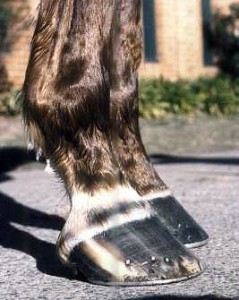
The horse has a broken back hoof-pastern angle, this leads to increased pressure up the front of the leg and increased stretch or strain to the tendons at the back of the leg, in other words it contributes to osteoarthritis, shin soreness, carpal bone and fetlock joint problems and bowed tendons. These feet are well overdue for shoeing and the shoes look untidy. This probably means they are loose. This horse already had a carpal bone chip fracture when this photo was taken.
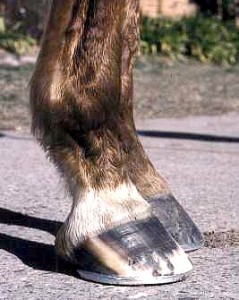
The hoof- pastern angle is normal. The nails are in the front half of the foot and are about a quarter to a third of the way up the wall at the point of exit. The shoes extend far enough back to provide a platform for the heels to expand on under load and allow for growth of the foot over time which will pull the shoe forward. The clip is the same angle as the wall and was seated into the wall and not tapped back.
- Breakdown caused by bad shoeing is the single most easily preventable cause of failure to race or achieve maximum potential. There is a correct shoe for each phase of training. Steel shoes are used in pre-training following the theory of the lighter the shoe the better. Light steel plates and training plates are used when fast work begins and do not add much length to the hoof wall and therefore make it easier for the toe to break over during each stride. Correct length of toe is important as it relates to the amount of work required by muscles and the tension of tendons to get the toe off the ground. Therefore, imbalanced or overlong feet contribute to fatigue and breakdown.
- Race horses should be frequently shod (3 – 5 weekly). A longer interval than this before reshoeing will lead to imbalance of the feet and contributes to long toe – low heels and racing injuries such as bowed tendons and joint problems.
- However, clips and nail holes damage the hoof wall with insufficient wall growth before reshoeing if care is not taken to minimise damage to the hoof wall. Pitching nails too high or behind the widest part of the foot restricts hoof function (expansion), but nails need to be driven high enough to be reused if possible. If a shoe is lost out of a strong area of hoof, the nail is pulled cleanly through.
- Clips can be set onto either side of the toe as paired side clips or singly, in rotation, to help prevent seedy toe. Tapping the clip back onto the wall should be avoided as this crushes the cells which produce the white line which grows off the end of the distal laminae (the distal edge of P3) and results in bruising tissue death, bone resorption, pedal osteitis and eventually seedy toe and hoof cracks.
- Racehorses often suffer post race soreness/trauma to the feet. A combination of lactic acid build up from exercise, inflammatory response and digestive disturbance from a high grain diet and over confinement places many horses on the verge of laminitis. A symptom is bruising of the white line which is very common. Farriery error such as cutting feet too short and sole pressure contribute to this syndrome which results in chronic low grade soreness often not noticed as lameness because it is occurring in all four feet.
- Spelling is supposed to give the horse a holiday but often the feet are worse when the horse returns than when it left. This is due to a rapid change in diet, exercise and environment. Horses should be let down before going to the paddock. Considering the care they receive, and money spent on them, many racehorses have very bad feet – underrun heels or contracted heels, flat feet, corns and lack of strong healthy hoof growth are common problems.
HORSES BREAK DOWN FROM THE GROUND UP!
The muscles of the leg have no control over the landing phase of the galloping stride; the hoof is like a pendulum on the end of a piece of string – it is thrown out and falls to the ground. Correct, balanced shoeing maximises stride potential; it does not lengthen it. Bad shoeing can shorten the stride, waste energy and cause breakdown. Galloping horses carry the whole body weight on the leading front leg. As the body is propelled forward from behind, the carpus, suspensory system and flexor tendons are under enormous strain and the front legs are most likely to break down at the weakest point or site of previous injury. Horses cannot run fast with sore feet, but I have seen many that try, failing to run on at the end of a race, lifting their heads instead of accelerating, running off at the bend, climbing or running slower than expected and pulling up distressed. This conforms with the concept of V Heart rate Max (VHM) this means that maximum velocity (speed), maximum heart rate, maximum oxygen transport and uptake are all reached at the same time and the horse then cannot go faster and is about to begin burning energy in the cells anaerobicly (without oxygen) this process then accelerates the production of lactic acid which rapidly brings on fatigue and the horse’s athletic potential has been reached. Training can increase a horse’s VHM but many factors such as maximum heart rate are genetically determined traits. It is now known that lameness will lower performance by causing a horse to reach it maximum speed, heart rate and oxygen transport to the cells (VHM) earlier.
Therefore, the horse will not be able to go as fast for as far despite having the same degree of fitness that it had when it was not carrying an injury or unsoundness.
Never underestimate the effect of even a mildly sore foot on a horse’s performance.
RECOMMENDED LINKS
|
|||||||||||||||
